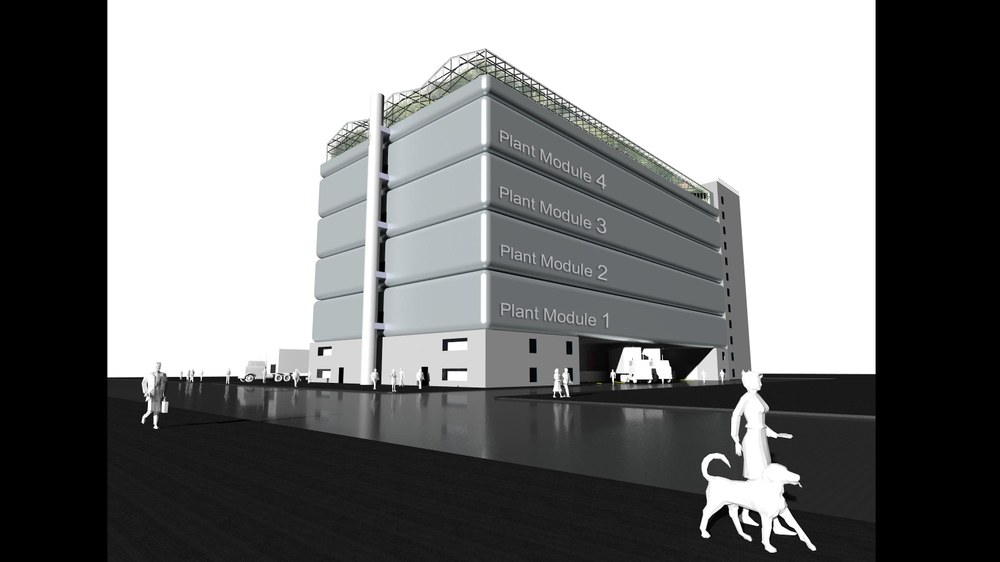Vertical farming – high-rise agriculture


Arable land disappeared from city centres, where most people live, many years ago. Nowadays, food is transported over long distances before reaching the consumer. Researchers from the German Aerospace Center (Deutsches Zentrum für Luft- und Raumfahrt; DLR) have now joined with international partners to create 'Vertical Farm 2.0', which will enable the multi-level cultivation of plants in large cities. This would allow for extremely short transport routes and would not need farmland at all. Lettuce, tomatoes, cucumbers and herbs could be cultivated and harvested all year round. "We would grow the plants in our production factory under precisely controlled and ideal conditions," explains Conrad Zeidler, Project Leader at the DLR Institute of Space Systems. "Our lettuce and tomatoes would not taste any different to the food that people buy in supermarkets today."
Although the 'greenhouse' would occupy a land area of no more than 74 by 35 metres, each storey could yield more than 630,000 kilograms of lettuce or 95,000 kilograms of tomatoes annually. The vegetables could be grown on different shelf levels accommodating various plants on each of the six-metre-high floors. This system would provide 5000 square metres to cultivate lettuce, or 1700 square metres for tomatoes, on each floor. The plants would be exposed to LED light and receive a precisely controlled nutrient solution. The DLR scientists are currently testing optimum lighting, the best possible irrigation system and ideal arrangements of the plants in their 'Evolution and Design of Environmentally closed Nutrition sources' (EDEN) laboratory. The Vertical Farm consists of five levels in total – four of them are designated to cultivate plants, whereas the lowest floor would house the logistics centre, the administration and the chilled rooms for multi-day storage, among other facilities. The technical systems such as the elevators and tanks would be installed at the centre of the building, the so-called 'core'.
Tailored to a variety of locations
"It is particularly important that the high-rise 'greenhouse' has a modular structure that will enable its adaptation to suit the specific requirements of each location," says Zeidler. For instance, if the demand for lettuce is particularly high in Tokyo and tomatoes are much in demand in Moscow the Vertical Farm concept should easily be able to cater for the wishes of the consumers. The principle that parameters such as humidity, light and nutrients are precisely controlled remains the same for each location. "This means that the plants will grow faster and therefore the growth process is more productive. We can even influence the taste by adjusting the parameters." The plants receive their nutrients in a liquid form so that soil is not necessary. "We have a clean cycle, sealed from the outside world, and therefore do not need any pesticides or chemical insecticides." The system will only need a relatively small amount of process water, as it is continually re-used. This kind of self-contained 'greenhouse' will also allow the scientists to do their research independently of the weather and the season.
The substantial amount of energy that the LED lighting requires is the greatest challenge at the moment. "Out in the field, the Sun provides this energy free of charge." Nevertheless, Zeidler remains confident: "LEDs are becoming increasingly efficient, which means the relative cost of their energy consumption will also drop over the next few years."
The engineers, biologists, technicians and architects involved in the planning of Vertical Farm 2.0 have taken a significant step forward following an interdisciplinary study conducted over several days in the Concurrent Engineering Facility (CEF) at DLR Bremen. The DLR experts completed this study in close collaboration with the Association for Vertical Farming, an umbrella organisation co-founded by DLR. "Our objective is ambitious – to build, together with our partners, a pilot vertical farm in Europe," says Daniel Schubert, Team Leader of the EDEN Group at DLR. A vertical farm of this kind could be used in many different areas: "Areas where arable land is not available due to poor soil quality and insufficient water, such as a desert, would be conceivable, for instance. The system would also be suitable for regions with very low temperatures, where traditional agriculture is extremely restricted."

